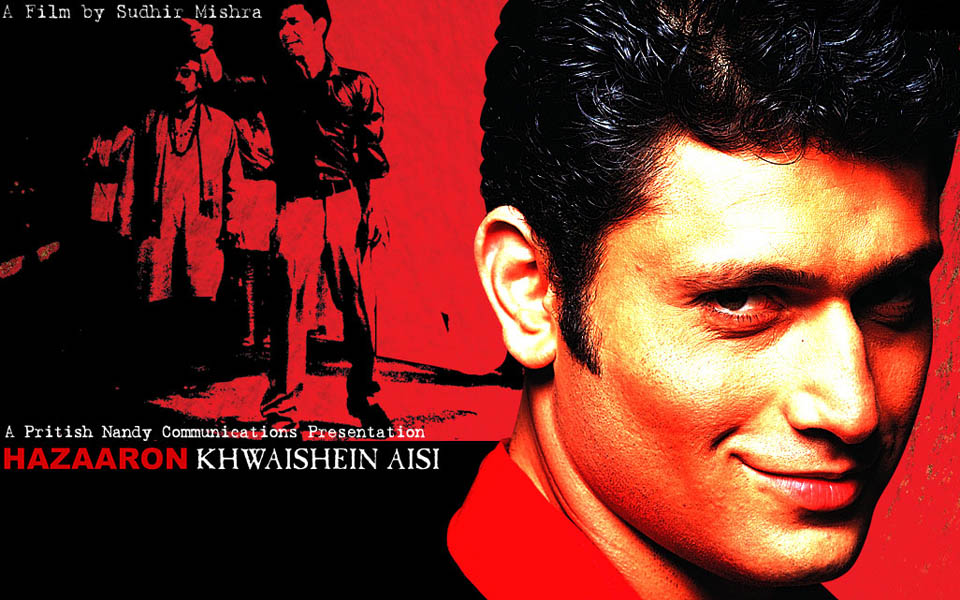
Sudhir Mishra’s 2003 movie Hazaaron Khwahishein Aisi made the film festival rounds before finally being released in India in 2005. I first watched this film in 2007 for MIT’s Passage to India course that delved into India’s past, present, and future. Starring Kay Kay Menon as the revolutionary Siddharth, Shiney Ahuja as the ambitious Vikram, and Chitrangada Singh as the idealistic Geeta, Hazaaron Khwahishein Aisi tackles a complicated love triangle among complicated characters during a complicated time of major social and political changes in India during the 1970s. More art film than mainstream Bollywood, this film wasn’t a huge box office success, but is definitely worth a watch to see a side of Indian cinema that very rarely gets its fair share of limelight.
The movie opens while Siddharth, Vikram, and Geeta are still college students and unravels to tell the story of these characters over the course of several years. The movie’s title, taken from an Urdu poem by Mirza Ghalib, means “a thousand desires such as these” — and as the story unfolds it becomes painfully obvious how unfulfilled each character’s desires will remain. The ups and downs of the film take the viewer through Siddharth’s uprisings in the villages of Bihar, Vikram’s financial successes as a fixer in Delhi and failures in love in his pursuit for Geeta, and Geeta’s blind dedication to Siddharth and his ideals at the expense of all her other relationships. Only through dire and irreversible circumstances at the end of the movie do any of the characters realize how fruitless and hopeless their individual missions were from the beginning.
Hazaaron Khwahishein Aisi doesn’t have your usual song and dance routines and certainly doesn’t have the most traditional Bollywood filmy kahaani, but the characters and their stories pull you in and keep you asking for more. Shiney Ahuja truly shines (I couldn’t help myself) in his debut film as the hopelessly-in-love Vikram. As much as I hated his character for refusing to move on with his life, I also admired his unconditional love for a woman who barely gave him the time of day. Kay Kay Menon (not to be confused with singer K.K. ) gave a powerful performance as the consumed-by-idealism-Siddharth, but I can’t say much more because I really disliked his character overall. Last, but certainly not least, Chitrangada Singh blew me away with her Bollywood debut thanks to her graceful portrayal of the complicated and frustrating Geeta. Part of me hated Geeta’s character because of her unrelenting tunnel vision, while another part me understood how and why she personified one of my favorite quotes from The Once and Future King: “Perhaps we all give the best of our hearts uncritically-to those who hardly think about us in return.”
When I first watched this movie so many years ago, I was most struck by the unconditional love demonstrated by Vikram for the oblivious Geeta in the face of her blind devotion to selfish Siddharth — but now, with a recent repeat viewing, I was also struck by the parallel nature of the film’s impossible love triangle with that of a doomed idealistic agenda.
The political history and ideology that’s oozing out of every scene of this movie was still a bit over my head, but it just made me want to learn more about the events that took place in such a pivotal decade for India. Watch this movie to see the side of Indian cinema that contemplates the loss of so many thousands of desires rather than making the impossible seem possible with happy endings galore.
Farah Naz Khan is an internal medicine resident at Emory University. After graduating from college in Boston, she returned to her Alabama hometown to attend medical school, and was reunited with the mix of Southern hospitality and South Asian flair that had shaped her childhood. Follow her on Twitter @farah287 or read some of her thoughts at farah287.blogspot.com.
Find The Aerogram on Twitter @theaerogram and follow it on Facebook.












